Menu
Met-Chem manufactures Inclined Plate Lamella Clarifiers designed to fit your needs and budget. We offer a large variety of clarifier sizes and options needed for your industry and application.
With over 60 years of experience, our team can help you select the right Clarifier for your needs, whether you need equipment for wastewater treatment, mining, plating, brewing, and any other tough industry. Let us help determine the correct clarifier size and capacity for your specific need.
During the manufacturing process, you are always welcomed to visit our shop in Cleveland, Ohio to see your new clarifiers being built. We will be happy to provide periodic updates with e-mailed photos if desired.
Met-Chem can provide delivery and installation of your new Clarifier, both Domestically and Internationally.
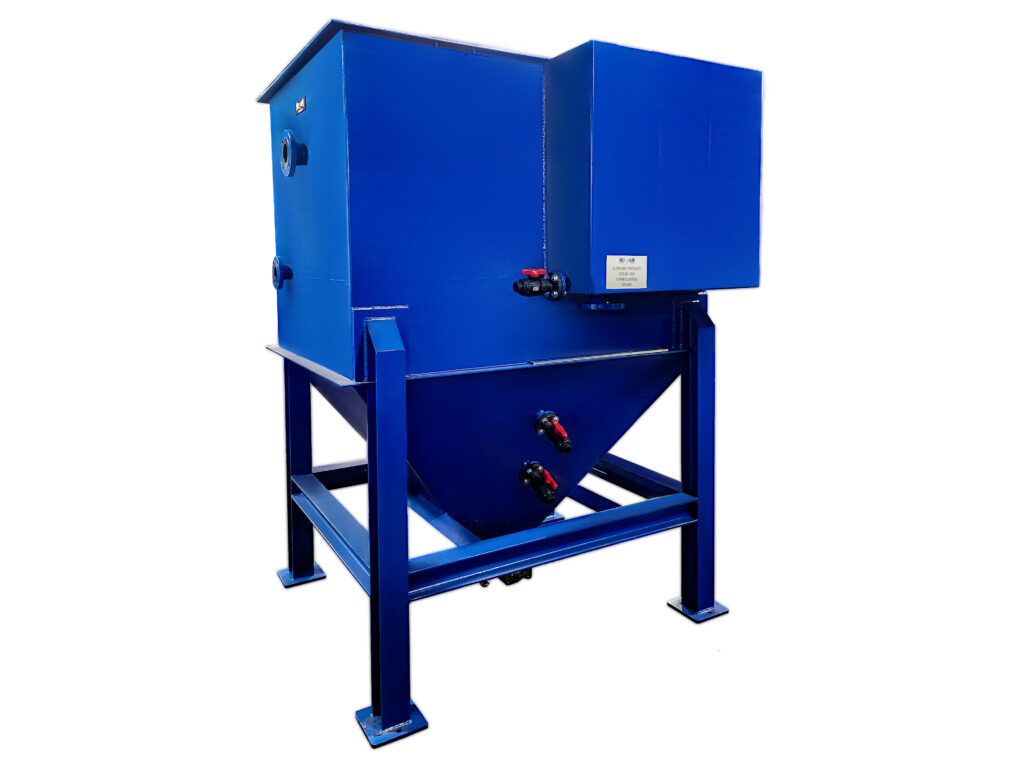
Floc Tank
Sludge Sample Ports
Pinch Valve
Clean Water Drain
Floor Drain
Wastewater Inlet
Floc Tank Drain
GPM | No. of Packs | No. of Cones | Projected Settling Area | Weight in Lbs. Operating – Dry | Dimensions L x W x H | |
2 | 1 | 1 | 13 | 3,000 | 1,200 | 4′ x 3′ x 6′ |
12 | 1 | 1 | 61 | 10,500 | 3,800 | 5′ x 5′ x 8′ |
15 | 1 | 1 | 89 | 12,000 | 4,200 | 6′ x 6′ x 9′ |
1 | 1 | 171 | 14,000 | 4,700 | 6’x 7′ x 10′ | |
2 | 1 | 342 | 38,000 | 7,500 | 8’x 11′ x 10′ | |
2 | 1 | 520 | 53,000 | 10,500 | 9’x 11′ x 12′ | |
4 | 2 | 685 | 81,300 | 15,000 | 14’x 12′ x 12′ | |
4 | 2 | 1041 | 110,000 | 18,300 | 18’x 12′ x 12′ | |
8 | 2 | 1388 | 125,000 | 21,900 | 24’x 10′ x 12′ | |
8 | 4 | 1475 | 140,000 | 25,000 | 27′ x 11′ x 12′ | |
The above units are standard sizes. Custom and larger clarifiers are available for design and purchase.
Meets EPA Discharge Limits for Metal Finishing Waste
The Met-Chem clarifier uses the time proven concept of inclined plate clarification. This type of clarifier uses gravity in conjunction with the projected settling area of the 60-degree angle plastic parallel plates to settle solids from the pre-treated liquid flow. This treated liquid flows first to the flocculation tank where a polymer is added to promote floc growth, then down to the bottom of the clarifier and up through the plate pack(s) while the solids settle out to the bottom sludge cone or cones – depending upon the size. The solids are intermittently taken from the bottom cone tank for a further settling of the solids and then, finally to a filter press for final dewatering. (Click Here for Clarifier Frequently Asked Questions)
Clarifiers for wastewater treatment, manufactured by Met-Chem are the inclined parallel plate design that are used as part of a wastewater treatment system for solids settling. They are constructed of carbon steel with coal tar epoxy lining on the inside, and epoxy coating on the exterior. Also available in stainless steel and polypropylene. The internal plate packs are set at 60 degrees for optimum settling and are constructed of a coal tar epoxy-coated steel shell with plastic plates.
To Establish More Effective Sludge Collection, We Would Recommend a Sludge Blowdown System.
This sludge blow-down system is designed to monitor the time the Clarifier is in use, i.e. when the pump that feeds the beginning of the gravity flow waste stream leading to the Clarifier, the timer is timing. After the predetermined time has elapsed, the controller will automatically open the discharge valve and activate the discharge pump to the sludge thickening Tank, and then automatically turn off the pump and close the valve. System includes: Sludge Valve, air valve and control panel with timers and cast iron diaphragm pump.
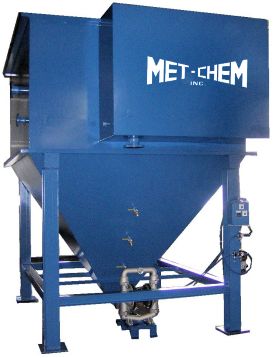
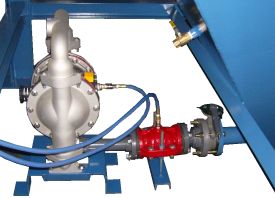
Met-Chem uses inclined parallel plates in both our square and rectangular clarifiers. These plates provide increased settling capacity by reducing the vertical distance a suspended particle must travel. Plastic plates that are inclined at a 60 degree angle slope upwards in the direction of flow. This structure creates a large number of narrow parallel flow pathways encouraging uniform settling. The stabilized solids collect on the plates, become heavier and slide back down the inclined plate to the bottom of the clarifier cone.

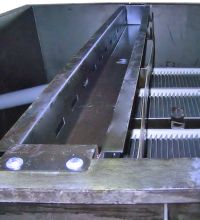
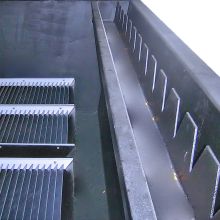
Inclined Plate Lamella Clarifiers are designed to remove solids from water. They are used in a wide variety of Wastewater Treatment Applications, including Metal Finishing Wastewater Treatment. The Total Suspended Solids (TSS) in the wastewater will naturally settle over time due to gravity, but this process can be sped up and improved by having Inclined Plates. The inclined plates provide a large projected settling area in a compact form. This technology is greatly beneficial compared to a cone bottom tank or a circular clarifier because of the space savings, settling efficiencies, and the reduced cost of construction.
Wastewater flows into the Clarifier at the top of the tank. Depending to help on the type of Wastewater Application you need, Flocculant and/or coagulants are added to help settle out the solids. The wastewater is fed via baffles to the bottom of the unit. This is where the settling process begins. Water flows up through the plates while the solids settle to the bottom of the clarifier.
After gravity settles the solids to the bottom of the clarifier, it is pumped into a sludge thickening tank for additional settling. From the sludge thickener, the sludge typically gets pumped through a filter press for final dewatering. The water from the filter press is returned back to the equalization tank, and the solids are safe for disposal.
Once the water is filtered and enters the top of the tank, it is typically safe for discharge. In some cases, additional water polishing is required.
Total Suspended Solids (TSS) will naturally settle over time due to gravity, but this process can be sped up and improved by having an Inclined Plate. Water flows up the plate at a 60° angle. Gravity will force the solids to settle onto the plate. The particles collect on the plates will become heavier and slide back down the plate to the clarifier cone. This process creates a counter flowing pattern, where the solids are separated from the liquid into two lanes of traffic. The water flows in the upward bound lane, and the sludge flows in the downward lane. This method reduces drag and friction creating a faster settling process than if the solids were to settle naturally.
Flocculants and Coagulants are added to improve the settling time. Coagulants neutralize the negative charge particles allowing them to sink faster. Flocculants allow for the small particles to collect and accumulate. This will make the solids heavier and easier to settle.
Inclined Plates allow for a compact design, therefore reducing the need for valuable floor space. The plates are angled at 60° allowing for an efficient projected surface area. Larger angles cast a smaller projected surface area, and shallower angles disrupt sludge flow and potentially could clog the plates. In the diagram, the Total Projected Surface Area graphically compares the equivalent floor space needed. One Standard Met-Chem Plate Pack is equivalent to a 15-foot diameter holding tank or a circular thickener.
Met-Chem’s design allows for a 50-60 minute retention time. This is a much better retention time than a traditional Parkson Style Clarifier which has nearly half the retention time. By having a greater retention time, this allows for more settling time, which improves the counter flowing pattern as described above. Moreover, a larger retention time Reduces the Risk to Overrun the Clarifier.
Met-Chem uses Inclined Parallel Plate Packs in our 240 GPM Clarifier. These plates provide increased settling capacity by reducing the vertical distance a suspended particle must travel. PVC plates that are inclined at a 60-degree angle slope upwards in the direction of flow. This structure creates a large number of narrow parallel flow pathways encouraging uniform settling. The stabilized solids collect on the plates, become heavier and slide back down the inclined plate to the bottom of the clarifier cone.
The Met-Chem’s 240 GPM Lamella Clarifier comes with 4 Plate Packs
Catwalk Systems provides easy access to Tanks and Clarifiers for operation, maintenance, and testing. Met-Chem will design to fit or retrofit existing systems. Catwalk systems could be comprised of stairs, ladders, guard rails, and landings.
Ask Met-Chem about a Catwalk System
The Automatic Sludge Blowdown System automates two times, the sludge collection time, and the sludge discharge time. The sludge collection time is when the clarifier is “in use” or the time it takes for sludge to settle in the cone of the clarifier. The sludge discharge time is when the pump transfers the sludge from the clarifier to the sludge thickening tank. The system will automatically open the discharge valve and activate the diaphragm pump, and after a predetermined time, it will automatically turn the pump off and close the valve. The system comes with a sludge valve, air valve, control panel with timers, and a cast iron diaphragm pump.
The Automatic Sludge Blowdown System reduces the need for manual operation. This will save you time and money on the cost of an operator. It will also maintain consistent wastewater flow. The system will also safeguard against sludge overflow, eliminating human error.
There are many wastewater applications that require Scum Skimming System. Solids that float towards the top of the wastewater is referred to as scum. A Met-Chem Clarifier can be outfitted with paddles to remove and collect the scum.
The paddles will skim the top of the wastewater in the clarifier. They will grab any floating solids and pull them into a collection point. Watch the video for a demonstration.
The solids that settle to the bottom will still be treated with a flocculant or polymer and settle to the bottom of the sludge cone with the clean water exiting the top. The Scum Skimmer will capture the floating solids, they will be captured and placed into a separate section of the clarifier to be removed. The solids can be pumped into the same cone bottom or a Filter Press for further dewatering.
Clarifier Case Study: Chipping away at disposal costs: With Met-Chem’s system installation, the effluent (liquid from the clarifier, which is virtually free of solids) is then pumped back to the Digester tanks. The settled solids from the cones of the clarifier are then filtered by a belt filter press and this dried cake, being a bio food waste, is hauled to the area farms to feed the cows.
Water Treatment Case Study: A Clean Lagoon is a Good Lagoon: Fiberboard Manufacturer’s existing system could not handle the volume of paper pulp being generated. They needed to clear out the sediment that was accumulating in their lagoon that was in violation of environmental regulations.
Waste Water Treatment Systems Case Study: Just to clarify…: A new boarding school needed to put in a self-contained sanitary waste treatment system to handle all water sources generated at their facility. Met-Chem designed and built two 120 GPM clarifiers with flocculation tanks, and custom catwalks built to fit space limitations and overlook and operate the waste treatment system.
Met-Chem, Inc.
837 East 79th St.
Cleveland, OH 44103
Phone: (216) 881-7900
Email: info@metchem.com
Copyright © Met-Chem, Inc